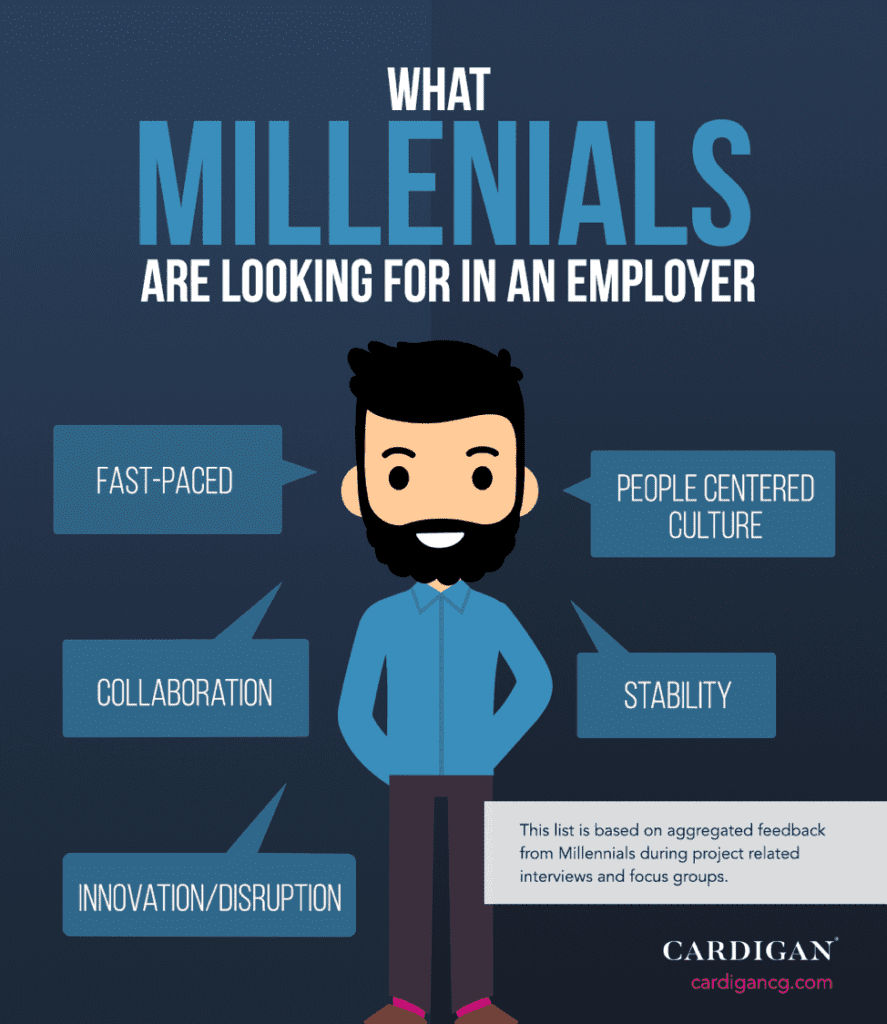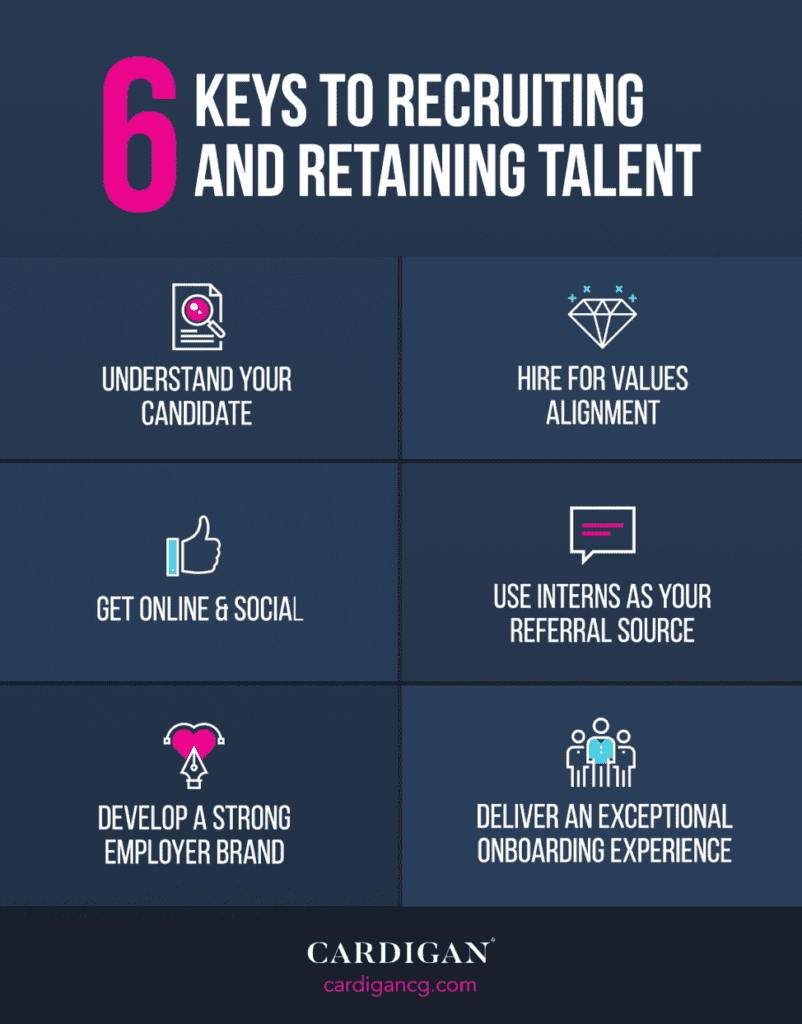It’s well-known that many of the workers and leaders in the energy sector are approaching retirement age, with 25% eligible in the next 5 years and 50% eligible in the next 10 years.
With fewer and fewer people filling the talent bench and an industry that’s fighting a negative public perception, the situation is only intensified by the fact that the workers most ready and able to fill the talent void are millennials—they may be ready and able to lead, but are they willing? Who they are and what they are looking for is still not fully understood by many talent acquisition leaders.
What Are Millennial Candidates Looking For?
Cardigan has done several focus groups at companies, universities, and co-working spaces to better understand what candidates are looking for in an employer. We always start by asking them to finish this sentence, “I want to work for a company that is…” Their top five answers are fast-paced, collaborative, innovative/disruptive, people-centered, and stable.
- Fast-paced—They are used to learning new technology and absorbing lots of information, so a fast-paced environment is important to keep them from getting bored.
- Collaboration—They love working in teams and learning from others’ ideas and experiences—this means more project and teamwork vs. working in silos.
- Innovation/Disruption—They want to be on the forefront and work for companies that are changing the industry, doing things that haven’t been done before. That level of challenge is appealing and keeps them engaged.
- People-centered—Long gone are the days when people give their all to a company with very little in return. Millennials expect it to be a mutually beneficial relationship and if the odds are ever not in their favor, they will look to leave. If you take care of them, they will be there for you. They grew up and saw how their parents were loyal to a company that wasn’t loyal to them when the numbers didn’t work out and they refuse to follow into the same trap.
- Stability—Last but not least is stability. After seeing what happened to their parents, working for a company that’s been around for many years and with long-tenured co-workers is actually appealing to millennials.
What can you do to make your company stand out? Take what candidates are looking for, see where there is a match between their wants and what your company has to offer—then communicate the heck out of it. It’s not just about changing your culture—it’s more of a yes, and…—but start with making the best with what you have.

Establish a Strong Employer Brand
Every organization should make a purposeful investment in the development and management of their employer brand—whether that is dollars invested each year, or time and energy of employees. But the one thing to remember is that employer branding is everyone’s job—not just HR—and when done well, it will set you up for success.
Unlike your company brand, which is your promise to your customers and written in marketing language with broad appeal, your employer brand is your promise to your employees and is written from a cultural perspective and is often segmented to reach appeal to different groups. Your employer brand speaks to your candidates in their voice (this is a key distinction).
When done right, you employer brand helps you shine a light on what your company has to offer, what makes it unique beyond salary and benefits—because anyone can copy or match those things. It can also help overcome the negative image the energy industry has with younger candidates. This is your chance to show candidates that you aren’t the energy organization of the past, and separate yourself from the rest of the pack.
Get Online and Social
The first thing anyone does to learn more about your company is a simple online search. Are you proud of your company’s online presence? Your company’s careers website is the perfect place to tell your story and show off what makes you unique—e.g., your employer brand.
Our research has found that millennial candidates are typically looking to see four things on your website; we call them the “4 P’s”: Personality, People, Places, and Projects.
The next place they will look is social media—LinkedIn, Facebook, and Instagram. These platforms allow candidates to see what’s happening around the office and read what people are saying. Social media platforms are kind of like the Glassdoor of employer brand because much of the content can be generated by employees.
Social platforms are also a great place to share the projects you are working on and to showcase the people behind them—while you are educating candidates on the great things your company does, an online feature is always a fun way to recognize high performing employees for their efforts. A “day in the life” employee profile (a.k.a. realistic job preview) can help potential applicants see themselves in the role, especially in those areas that you may have trouble filling.
What’s happening right now is a great example. While many workers are practicing social distancing due to COVID-19, the energy Industry is hard at work—show your people out there on the front lines, literally keeping the lights on for communities and hospitals, and tell their stories. Talk about the new tech you’re using. Talk about partnerships with government entities and how its aiding in the fight. That is what is going to connect with your candidates.
If millennials want to be a part of something bigger than themselves, there is probably nothing more meaningful right now, and nothing more American than to fight in this crisis.
Make Sure Your Interns Have an Amazing Experience
This one hits a little more on Gen Z than millennials unless they are graduate students, but if we want to build our bench we must think ahead. Think of your interns as your best referral resource. When everyone gets back to school, they will compare stories—how they were treated, the projects they worked on, the new and exciting technology they learned to use, and yes, the pay. So, make sure your intern program is competitive and you are assigning challenging and meaningful projects that will allow them to see the results before they leave your campus. The amount of goodwill and promotion you will get on social media will do so much for your brand as an employer and make it easier to recruit moving forward.
What Can You Do to Retain Them?
Select employees whose values align with your own. When we have an employee that turns in a resignation letter and we don’t want to lose them, we often try to match the offer dollar for dollar and promotion for promotion. Though more pay is often a reason for leaving an organization, increases in pay have diminishing returns on keeping employees.
The majority of the millennials we’ve interviewed or focused-grouped are seeking companies that have similar values, and companies that are tackling the problems they want to tackle. It’s more about the mission and the work. So, if you’re honest about your values and the problems you are trying to solve, you will attract people who believe what you believe—which is exactly what you want.

Have a Killer Onboarding Process
Almost 30% of new employees quit within the first 90 days of a new job. The reason many people leave organizations in this window is that most organizations do a poor job of onboarding new employees. Many organizations do a great job courting candidates but are making promises that their company culture and orientation can’t keep.
An exceptional onboarding experience is critical to making your new employee feel welcome, and showing them the alignment between your company values and their own. Below are four components to a best-in-class onboarding experience:
- Experience Over Presentation—No one wants to watch a boring presentation. Get people up and moving, focus on activities that teach.
- Build a Cohort—If you have a best friend at work, you are less likely to leave than someone who doesn’t. Building connection through their cohort gives them a “phone a friend,” and also strengthens your team.
- Live the Values—It’s great to talk about your value of service (everyone has one) but how is that operationalized at your company? Allow employees to see and experience the values in real life.
- Celebrate—Once it’s time to “graduate” new employee orientation, make it a big deal. People will always remember how you made them feel, and you want them to know that you are happy to have them in your organization.
The key to attracting and retaining talent of any generation is clarity about the candidate you’re going after, understanding their needs, speaking honestly about how you can meet those needs, welcoming them into your organization, and creating a space that lets them do their best work every day.
—Dr. Harold Hardaway is a speaker and thought leader on corporate communications and culture. He believes that everyone should “Chase the Good” and centers his work on helping organizations create spaces where that’s possible. He was previously the Director of Corporate Communications and Culture for H-E-B, and today, he serves as Co-Founder and CEO of Cardigan and oversees research and strategy for all client projects. Shannon Hernandez, C.H.C., is a gifted communications and marketing strategist who has made a name for herself creating game-changing communication and health and wellness initiatives that facilitate organizational and personal growth for some of Texas’ most beloved brands. Today, she serves as Chief Creative Officer for Cardigan and oversees creative and video production for all client initiatives, she also puts her passion for health to work as a Certified Health Coach, leading up the development of Health & Wellness Programming.










